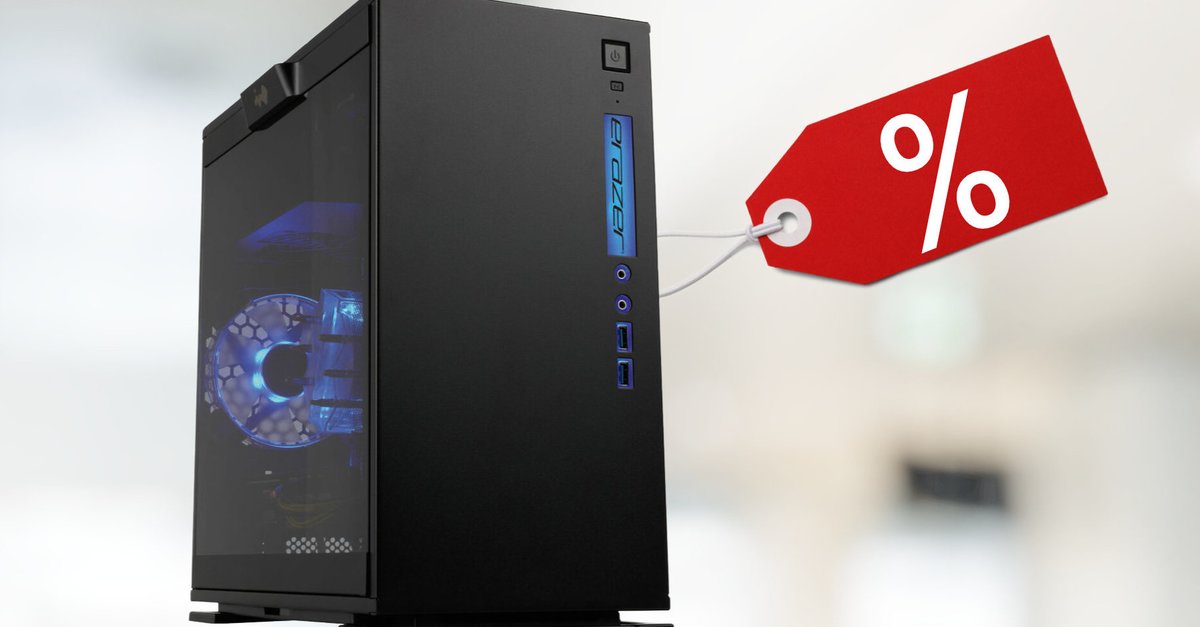That brings the new WLAN standard
Wi-Fi 6 is now the standard in many devices, and the successor Wi-Fi 6e, which also makes use of the six gigahertz spectrum, is gradually spreading. But the next Wi-Fi generation is just around the corner. The first manufacturers have even announced the first modems and products. But what will the next generation of the radio standard bring?
One of the co-developers of the Wi-Fi 7 standard is Mediatek. The company anticipates that “with the advent of Wi-Fi 7, Wi-Fi will be the first true wireline/Ethernet replacement for very high-bandwidth applications,” said Alan Hsu, corporate vice president and general manager for Intelligent Connectivity at Mediatek.
The manager sees the new WLAN standard not only as the backbone of home, office and industrial networks, but also for the development of “seamless connectivity”, for example from AR/VR applications to cloud gaming and 4K calls to 8K streaming – and beyond.
Some application areas of Wi-Fi 7. (Screenshot: Lancom)
With the introduction of Wi-Fi 6e, the 2.4 and 5 gigahertz frequencies previously used by WLAN networks were supplemented by the six gigahertz band. The third band provides relief for the 2.4 and 5 gigahertz frequency bands previously used across the board. These two are widely available and accordingly crammed with many devices, resulting in mutual interference and speed throttling or loss of range.
Editor’s Recommendations
Like Wi-Fi 6e, Wi-Fi 7 will also transmit on the three bands and will also be fully backwards compatible with the older wireless standards Wi-Fi 4, 5 and 6. However, the new standard should turn the speed screw properly: While Wi-Fi 6 and 6e are possible up to 9.6 gigabits per second, according to Mediatek, Wi-Fi 7 should ideally enable up to 46 gigabits per second. The Wi-Fi Alliance and IEEE are a little more conservative with their forecasts and expect rather up to 30 gigabits per second.
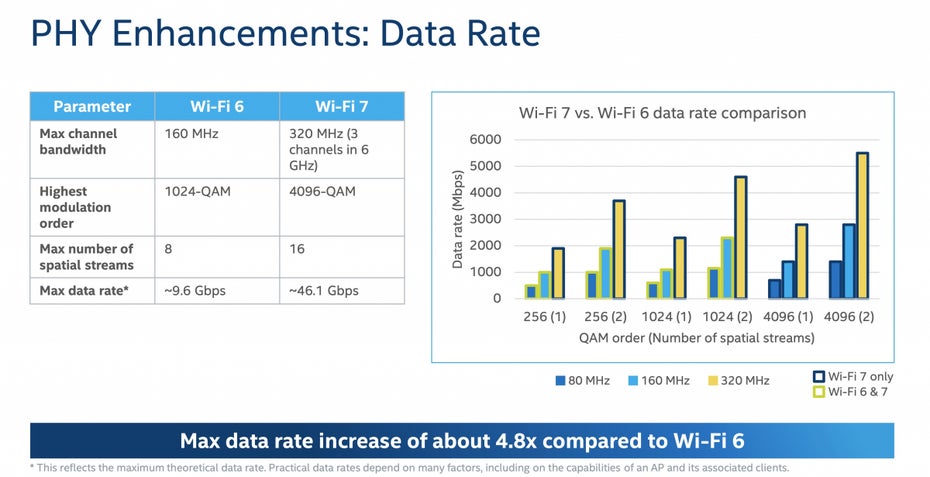
Some differences between Wi-Fi 6 and Wi-Fi 7. (Image: IEEE; Intel)
The higher data throughputs are made possible, among other things, by a larger maximum channel width: Because Wi-Fi 7 supports a spectrum of up to 320 megahertz – with Wi-Fi 6 it was only 160 megahertz. This higher bandwidth is in turn realized by the six gigahertz frequency.
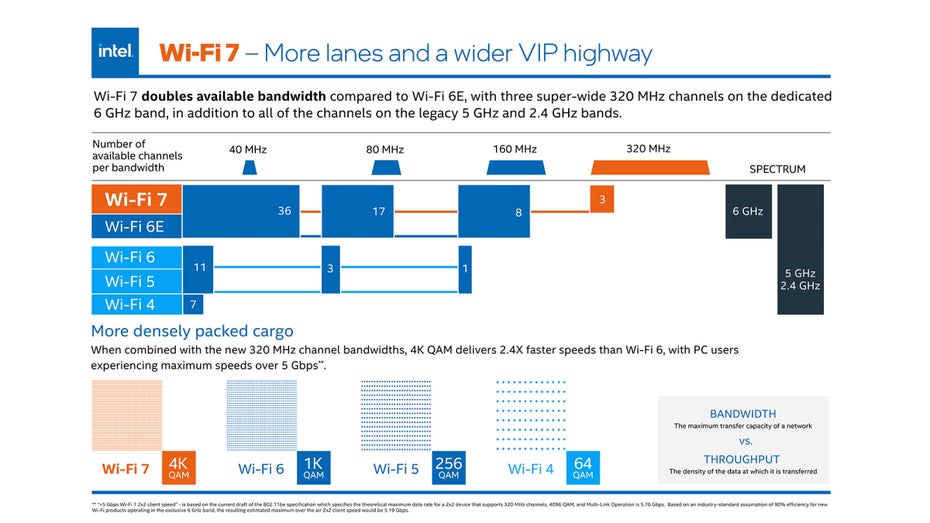
Among other things, Wi-Fi 7 uses a wider spectrum and more channels. (Screenshot: Intel)
In the EU, however, there is still a problem with the full use of the six gigahertz spectrum: so far only 480 megahertz of the total of 1,200 megahertz have been approved for use in this country. This circumstance means that neighboring WLAN networks can get in each other’s way with a channel width of 320 megahertz.
However, the high speed also requires a router that transmits with 16 antennas. This in turn requires that both the transmitting and receiving devices support Wi-Fi 7. However, the range and nature of the premises also play a role here. The six-gigahertz band does not have the long range of a 2.4-gigahertz band, and thicker walls or crooked apartments also impair high throughput or the WLAN signal.
| WiFi 5 (802.11ac) | WiFi 6 (802.11ax) | WiFi 6E (802.11ax) | WiFi 7 (802.11be) | |
|---|---|---|---|---|
| introduction | 2013 | 2019 | 2021 | 2024 (expected) |
| IEEE standards | 802.11ac | 802.11ax | 802.11ax | 802.11be |
| Maximum data rate | 3.5 Gbps | 9.6 Gbps | 9.6 Gbps | 46 Gbps |
| clock frequency | 5GHz | 2.4GHz, 5GHz | 2.4GHz, 5GHz, 6GHz | 2.4GHz, 5GHz, 6GHz |
| bandwidth
(Channels) |
20, 40, 80, 80+80, 160MHz | 20, 40, 80, 80+80, 160MHz | 20, 40, 80, 80+80, 160MHz | 20, 40, 80, 80+80, 160, 320MHz |
| access
(multiplexing) |
OFDM | OFDMA | OFDMA | OFDMA |
| modulation | 254QAM | 1024QAM | 1024QAM | 4096 (4K) QAM |
| antenna (MIMO) | DL MU-MIMO (4×4) | DL + UL MU-MIMO (8×8) | DL + UL MU-MIMO (8×8) | DL + UL MU-MIMO (8×8) |
| Security | WPA2 | WPA3 | WPA3 | WPA3 |
| Important innovations | 40MHz mandatory | TWT, BSS coloring, beamforming | TWT, BSS coloring, beamforming | multi-link operation (MLO), Multi-RU, piercing |
However, the higher data throughput is only one factor for many of the solutions. Because the higher data rates of Wi-Fi 7 are to be realized, among other things, by the multi-link operation technology (MLO). Compatible devices use several frequency bands – i.e. around five and six gigahertz in parallel – as a channel for sending and receiving data.

Wi-Fi 7 supports Multi-Link Operation technology, which allows devices to send and receive data over multiple radio bands at the same time. (Illustration: Qualcomm)
MLO ensures both lower latency and the delivery of faster and more reliable video streaming, games and other applications that require constant data throughput in real time. In addition to MLO, orthogonal frequency division multiple access (OFDMA) is also used to reduce latency, which is also used in Wi-Fi 6.
OFMDA flexibly divides individual WiFi channels into smaller resource units that a router can dynamically allocate to many devices. This makes better use of the available bandwidth and increases capacity. In addition, this technology should reduce battery consumption during data transmission.
As far as the latency times are concerned, there are currently no concrete values; however, some assume a “worst-case latency” of between five and ten milliseconds. In general, gamers, among others, benefit from minimal latencies in online games, since the delay in the transmission of data and commands is less delayed. But also in the areas of virtual (VR) and augmented reality (AR), a minimal input lag is elementary for a smooth user experience.
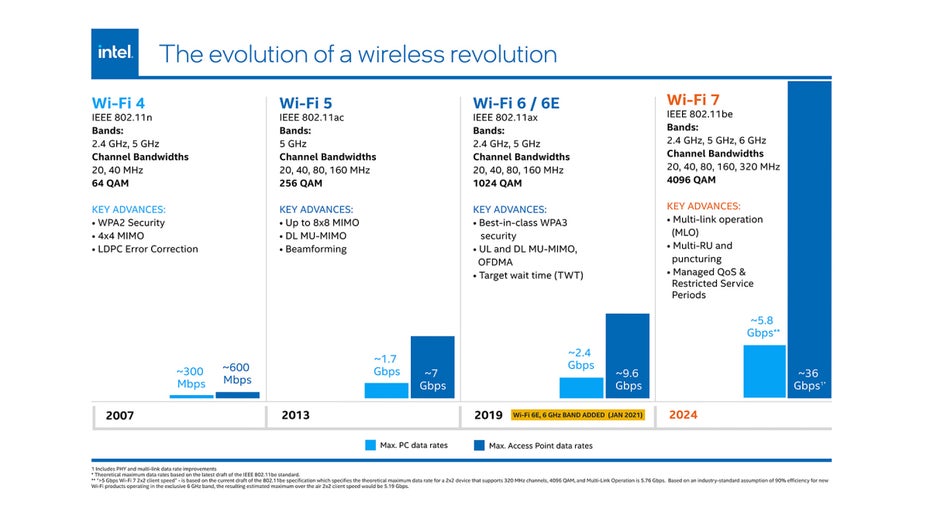
The evolution from Wi-Fi 4 to Wi-Fi 7. (Screenshot: Intel)
Furthermore, Wi-Fi 7 will use 4K-QAM technology instead of 1024-QAM (quadrature amplitude modulation or 1K QAM). The 802.11be standard should also support 16 instead of 8 antennas for receiving and transmitting data (Massive MIMO).
This means that corresponding future Wi-Fi 7 routers will then be able to process up to 16 data streams (16×16 MIMO) and communicate with even more WLAN devices at the same time. This full antenna expansion stage will tend not to be available for smartphones and laptops.
According to Intel a potential maximum data rate of almost 5.8 gigabits per second could be achieved with a Wi-Fi 7 laptop or smartphone with two antennas. This speed is 2.4 times faster than the 2.4 gigabits per second possible with Wi-Fi 6/6E. This could, for example, “enable high-quality 8K video streaming without any problems or reduce the downloading of a huge 15 gigabyte file to about 25 seconds”. With current WiFi, it would take a minute at best.
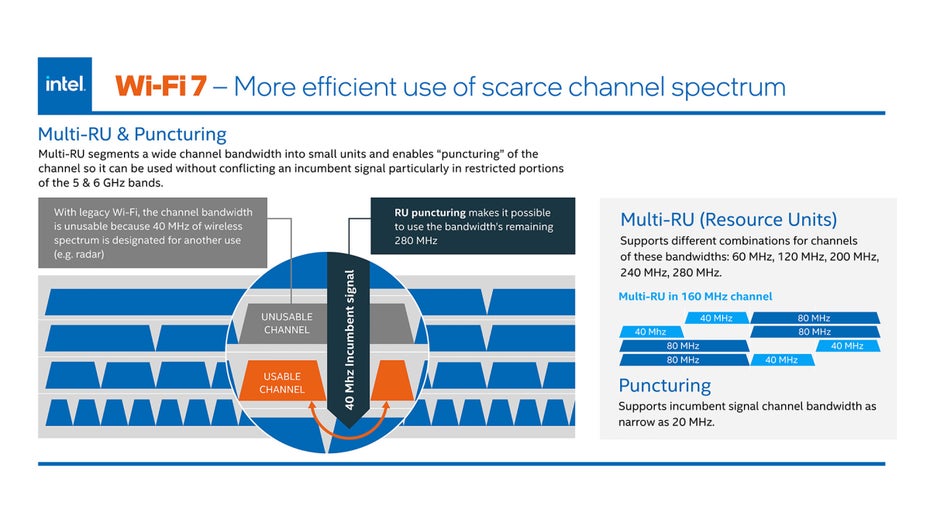
Multi-RU visualized by Wi-Fi 7. (Screenshot: Intel)
Multi-RU is also new: While Wi-Fi 6 was only able to send to and receive from one device on one assigned resource unit (RU), the new radio standard allows unused channel resources to be used for further Wi-Fi 7-enabled devices.
The standardization of Wi-Fi 7 is not yet final, it should be but by early 2024. Nevertheless, the first products such as routers and smartphones with the corresponding capabilities on board have already been announced. So far, however, these have been referred to as Wi-Fi 7-ready.
Among others, Qualcomm, Mediatek, Broadcomm and other corresponding radio chips installed in devices that currently still transmit with Wi-Fi 6e. The Wi-Fi 7 capabilities will later be activated via a software update.
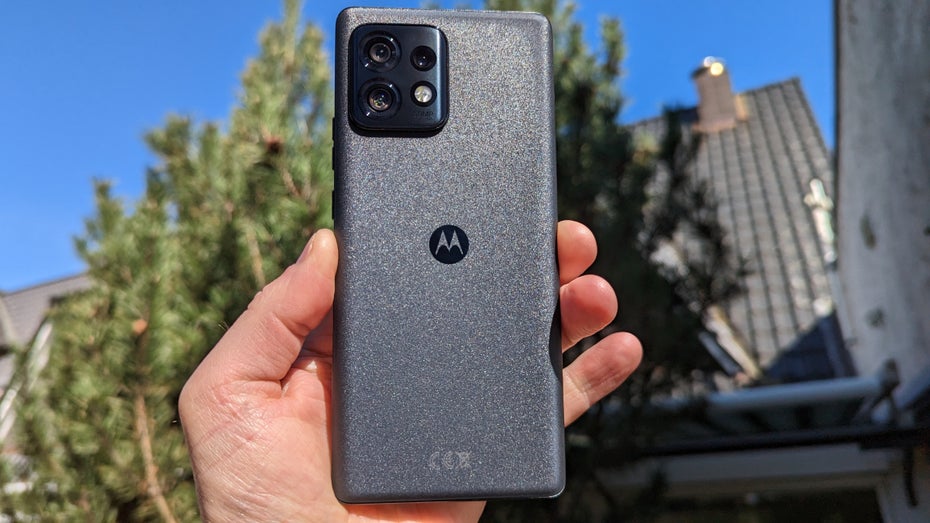
Motorola’s Edge 40 Pro already has Wi-Fi 7 on board. (Photo: t3n)
On the smartphone side, these include the Xiaomi 13, 13 Pro and Ultra. The Vivo X90 Pro Plus, Motorola’s Moto Edge 40, the Oneplus 11 Pro and the Honor Magic 5 also have corresponding modems. On the router side, manufacturers such as TP-Link and AVM are at the forefront.
The chip developer Intel is also playing in the Wi-Fi 7 game and wants to deliver the first chips for notebooks from 2024. There are no clear announcements from Apple about Wi-Fi 7 adoption. The last products shipped with Wi-Fi 6e. The iPhone 15, which will be released in autumn, should also receive the current wireless standard.
Meanwhile, it is rumored that the iPhone 16, due for release in autumn 2024, could have Wi-Fi 7 on board to seamlessly connect to the Vision Pro headset.
In the long term, Wi-Fi 7 will replace the current Wi-Fi 6 and 6e standards and will be installed in all products in the future. But that could take a few more years.
Even if Wi-Fi 7 will sooner or later be used in all conceivable consumer products, the wireless standard should really develop its performance where fast data transmission with many devices and the lowest possible latency is required. This primarily includes industrial IoT and Industry 4.0, but also telediagnostics and telesurgery. In the private sphere, Wi-Fi 7 will primarily show its muscles in VR and AR.


